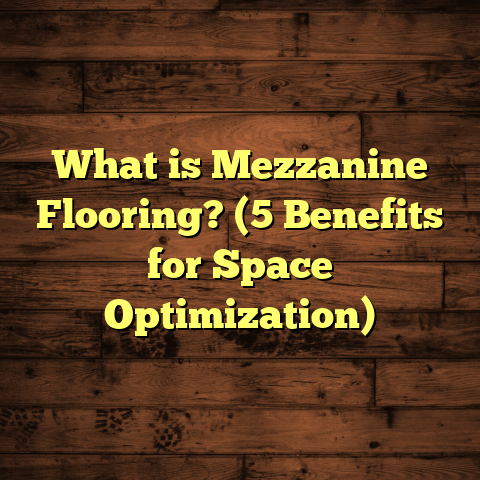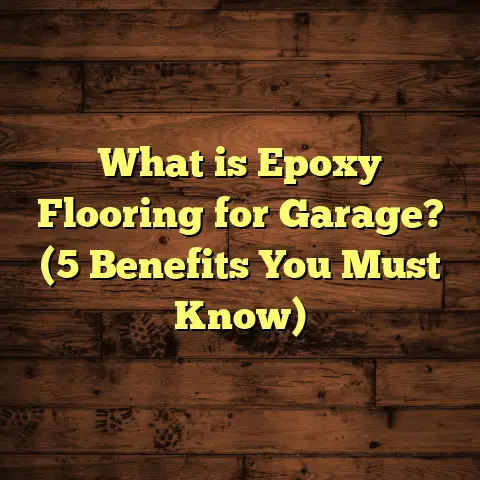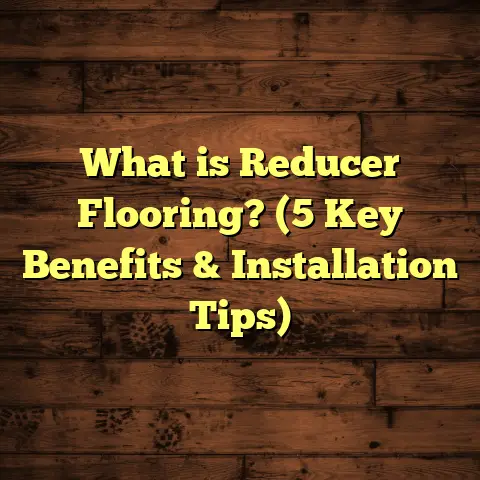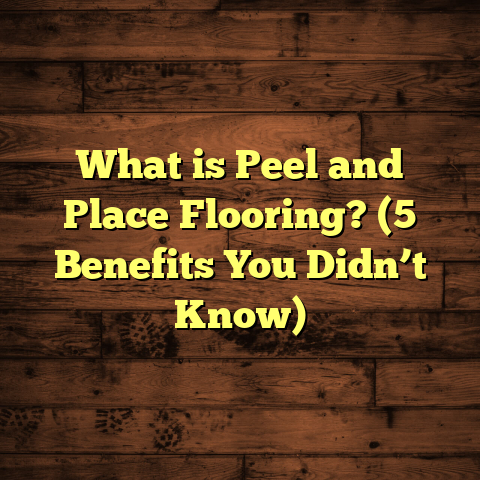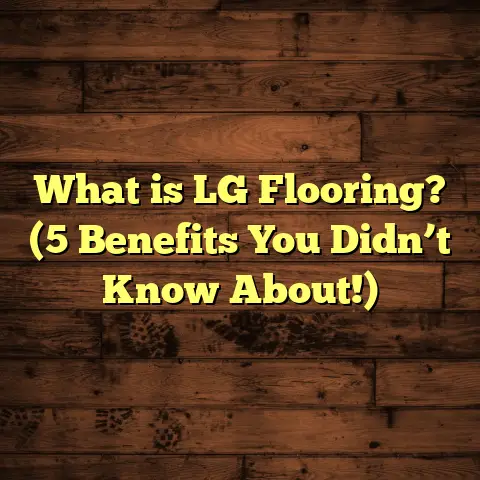What is High-End Vinyl Flooring? (5 Benefits for Luxury Spaces)
Would you rather invest in flooring that feels like genuine hardwood or natural stone but doesn’t come with the usual headaches—like high costs, difficult maintenance, or vulnerability to moisture? If you’ve been searching for that perfect balance between luxury and practicality, high-end vinyl flooring might just be your answer.
What is High-End Vinyl Flooring?
High-end vinyl flooring is a type of luxury vinyl flooring designed to provide the premium appearance and texture of natural materials such as wood, stone, or ceramic tile. Unlike standard vinyl flooring you might find in basic renovations, high-end vinyl offers superior construction, aesthetics, and performance suitable for upscale residential and commercial spaces.
The Science Behind High-End Vinyl
At its core, high-end vinyl flooring is primarily composed of polyvinyl chloride (PVC), a durable plastic polymer. But it’s not just a single sheet of vinyl slapped on the floor. There’s a sophisticated layering system designed to maximize visual appeal and functional durability:
- Backing Layer: This bottom-most layer provides stability and moisture resistance. It’s usually made from foam or fiberglass-reinforced vinyl to prevent warping.
- Core Layer: This is where the “luxury” part starts to show. The core can be flexible vinyl or more rigid composites such as WPC (wood plastic composite) or SPC (stone plastic composite). SPC cores are made with limestone powder mixed with PVC and stabilizers, which results in an extremely hard and dense core that resists dents and moisture.
- Design/Print Layer: Using high-definition digital printing technology, manufacturers create photo-realistic images that mimic wood grain, stone veining, or tile patterns. This layer often features embossed textures to enhance realism.
- Wear Layer: The top protective coating shields the floor from scratches, stains, and fading. High-end products include thick wear layers (typically 20-40 mils) made from urethane or aluminum oxide for longevity.
Advanced Manufacturing Techniques
When I first learned about these manufacturing processes, I was impressed by how much technology goes into making a floor look and perform so well. For example:
- Digital Printing: The print layer uses multiple inkjet heads firing millions of tiny droplets to replicate natural materials with unmatched detail. This process allows customization of colors and patterns.
- Embossing: After printing, the floor surface undergoes embossing—pressing textures into the wear layer to match the visual patterns. This texture trick fools your eye and touch into believing it’s real wood grain or stone.
- Curing: The wear layer is cured using UV light to harden coatings instantly, improving durability without compromising flexibility.
These technologies mean that today’s high-end vinyl floors blur the lines between synthetic and natural surfaces like never before.
My Journey with High-End Vinyl Flooring
I remember my first encounter with high-end vinyl flooring during a large renovation project for a boutique hotel lobby downtown. The client wanted something that would impress guests with its luxurious appearance but withstand heavy foot traffic and occasional spills.
We opted for SPC luxury vinyl tile that resembled Italian marble, complete with subtle veining and gloss finish. Installation took less than a week for nearly 3,000 square feet and the end result was stunning. Guests often complimented the floor’s beauty while staff appreciated its durability and ease of cleaning.
That project opened my eyes to the potential of luxury vinyl as a serious contender in high-end design—not just a budget option. Since then, I’ve installed it in everything from upscale condos to commercial showrooms.
5 Benefits of High-End Vinyl Flooring for Luxury Spaces
1. Unmatched Aesthetics That Fool the Eye
How often have you walked into a room and admired the floor without guessing it wasn’t real wood or stone? That’s exactly what high-end vinyl achieves.
The secret lies in advanced printing and texturing techniques mentioned earlier. These floors can replicate wide planks of rustic oak with hand-scraped textures or sleek marble tiles with subtle veining and shine.
In fact, surveys show that over 70% of homeowners who switch from hardwood or stone to luxury vinyl do so because they can get the look they want without sacrificing other benefits.
In my experience, clients value customization too. Some manufacturers now offer bespoke patterns or even incorporate metallic or pearlescent elements for unique finishes—perfect if you want to make a bold design statement.
2. Exceptional Durability for High-Traffic Areas
Luxury spaces often see a lot of foot traffic—whether it’s busy hotel lobbies, corporate offices, or vibrant residential kitchens. High-end vinyl flooring holds up remarkably well under these conditions.
Thanks to thick urethane or aluminum oxide wear layers, these floors resist scratches from heels, furniture dragging, pet claws, and even accidental drops of sharp objects. Plus, SPC cores prevent dents that would permanently mar softer hardwood floors.
To back this up with data: According to a report by the Resilient Floor Covering Institute (RFCI), high-end LVT products maintain their appearance under commercial foot traffic for up to 15 years without needing replacement.
I recall a retail store we worked on where customers constantly walked in wearing boots during winter—yet the luxury vinyl floors showed almost no signs of wear after three years.
3. Waterproof Qualities Make It Ideal for Wet Environments
One huge drawback of hardwood is its sensitivity to moisture—it can swell or warp if exposed to water. Stone is waterproof but cold and hard underfoot.
High-end vinyl flooring solves both problems by being completely waterproof. The PVC material doesn’t absorb water, and SPC cores add extra protection against moisture seeping from below.
This makes it an obvious choice in kitchens, bathrooms, laundry rooms, basements, and even outdoor covered patios.
Here’s an example: A client living near the coast wanted beautiful floors but battled constant humidity and occasional flooding. We installed SPC luxury vinyl planks throughout her home including bathrooms. Over two years later, no swelling or damage has occurred.
4. Comfort & Sound Absorption Enhance Living Spaces
Walking on tile or stone can feel hard and cold; hardwood is warmer but still firm on joints.
Luxury vinyl brings softness underfoot because of its layered construction and possible cushioned backing options. Some products come with attached foam underlayment that dampens sound—a blessing in apartments or condos where noise travels easily.
Personally, I installed LVP (luxury vinyl plank) with acoustic backing in my home office. It reduces footstep noise dramatically compared to laminate or hardwood installed directly on subflooring.
Clients often tell me they appreciate how quiet these floors are compared to ceramic tile or engineered wood—especially in multi-story buildings.
5. Cost-Effectiveness Over Time Makes Sense Financially
The initial investment for high-end vinyl flooring usually falls between $4 and $8 per square foot depending on brand and thickness. Installation costs add roughly $2-$4 per square foot due to easy click-lock systems or glue-down methods.
Compare this with hardwood floors which can cost $6-$12 per square foot plus higher installation fees due to complex subfloor prep and finishing requirements.
While hardwood can last longer (20-40 years), luxury vinyl’s durability combined with low maintenance means fewer repairs and refinishing costs over time.
When planning budgets for my projects, I rely on FloorTally—a tool that helps me estimate material needs, labor costs based on local rates, waste factors, and total project expenses quickly. It saves me time by consolidating multiple quotes into one accurate figure so I can give clients reliable estimates upfront.
This approach simplifies decision-making when balancing design aspirations with financial realities.
Diving Deeper Into Technical Specifications
Let me break down some key technical details I always review when selecting high-end vinyl flooring:
| Specification | Explanation & Impact |
|---|---|
| Wear Layer Thickness | Thickness ranges from 20 mils (light commercial) to 40 mils+ (heavy commercial). Thicker layers resist scratches better and extend lifespan. |
| Overall Thickness | Typically 4mm-8mm; thicker floors feel more solid and provide better sound insulation. Thinner options may feel hollow underfoot. |
| Core Type | SPC cores offer rigidity and moisture resistance; WPC adds warmth through wood composite but slightly less dense; flexible cores are budget-friendly but less durable. |
| Surface Finish | Matte finishes hide scratches better; gloss finishes shine but can reveal wear more quickly. Options include textured finishes for grip especially in wet areas. |
| Installation Method | Click-lock systems are DIY-friendly; glue-down is permanent but requires more prep; loose lay allows easy replacement but may shift without adhesive. |
| Warranty | Look for warranties between 10-25 years covering wear-through, staining, fading—an indicator of product quality. |
Understanding these specs helps me recommend the right product for each project’s needs—whether it’s for a residential kitchen that needs waterproofing or a commercial showroom requiring heavy-duty wear resistance.
Case Studies: Real Projects & Outcomes
Case Study 1: Luxury Condo Kitchen & Living Area
A client wanted the warmth of hardwood floors but struggled with spills and humidity in her kitchen area on the 15th floor of a city tower.
We installed 6mm thick SPC luxury vinyl planks with a matte finish that replicated white oak perfectly. The waterproof core meant she didn’t worry about water damage from cooking mishaps or rainy days tracked inside.
After 18 months, she reported zero damage despite heavy use by her family and pets plus ease of cleaning with just a damp mop.
Case Study 2: Boutique Hotel Lobby Flooring
For the hotel lobby I mentioned earlier, we used luxury vinyl tile mimicking Calacatta marble with subtle gold veining matching the décor.
The floors had to withstand thousands of guests monthly plus luggage wheels dragging across surfaces without losing luster.
After three years running at full capacity, maintenance crews say the floors still look brand-new thanks to durable wear layers and easy stain removal properties.
Unique Insights: What I’ve Learned Over Time
Through years installing various flooring types, here are some lessons about high-end vinyl floors:
- Not All Vinyl Is Created Equal: The market has exploded with products labeled “luxury,” but quality varies widely. Always check wear layer thickness and core material.
- Installation Matters: Even the best materials fail if installed poorly—subfloor prep must be level and clean.
- Environmental Impact: Some brands now offer low-VOC emissions certified products which improve indoor air quality—important in luxury homes emphasizing wellness.
- Maintenance Is Simple but Necessary: Regular sweeping and occasional mopping keep floors looking fresh; avoid abrasive cleaners or wax-based products.
- Resale Value: While hardwood remains king here, high-end vinyl adds appeal in urban markets where buyers want stylish yet practical solutions.
Frequently Asked Questions About High-End Vinyl Flooring
Q: Can high-end vinyl be refinished like hardwood?
A: No, vinyl cannot be sanded or refinished. However, its thick wear layers are designed to last many years before replacement is needed.
Q: Is it safe for radiant floor heating?
A: Yes! Most luxury vinyl products are compatible with radiant heating systems since they conduct heat well without damage.
Q: How long does installation typically take?
A: For an average home (1,000-2,000 sq.ft.), installation ranges from 2-5 days depending on subfloor preparation and room complexity.
Q: What about environmental friendliness?
A: Some manufacturers now produce recyclable products with reduced chemical emissions. Ask your supplier about certifications like FloorScore® or GREENGUARD®.
Wrapping Up My Thoughts on High-End Vinyl Flooring
If you’re aiming for floors that impress visually while standing up to real life’s challenges—think kids, pets, spills, humidity—high-end vinyl flooring hits that sweet spot beautifully. It combines cutting-edge manufacturing with thoughtful design resulting in resilient, stylish surfaces perfect for luxury spaces.
I’ve seen how it transforms homes and commercial environments alike by offering warmth, elegance, comfort, and practicality all rolled into one. Plus, tools like FloorTally make planning financially sensible projects easier than ever.
Thinking about updating your floors? I’m here to help answer questions anytime based on your unique needs—just reach out!
